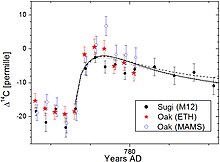This is an old revision of this page, as edited by BG19bot (talk | contribs) at 07:06, 12 December 2015 (→Hypotheses: WP:CHECKWIKI error fix for #61. Punctuation goes before References. Do general fixes if a problem exists. - using AWB (11756)). The present address (URL) is a permanent link to this revision, which may differ significantly from the current revision.
Revision as of 07:06, 12 December 2015 by BG19bot (talk | contribs) (→Hypotheses: WP:CHECKWIKI error fix for #61. Punctuation goes before References. Do general fixes if a problem exists. - using AWB (11756))(diff) ← Previous revision | Latest revision (diff) | Newer revision → (diff)The 774–775 Carbon-14 Spike was an increase of 1.2% in the carbon-14 content of tree rings during the years 774 or 775 CE, which was about 20 times as high as the background rate of variation. It was found during a study of Japanese cedar trees, with the year of occurrence determined through dendrochronology. A surge in a specific isotope of beryllium (Be), detected in Antarctic ice cores, has been associated with the 774-775 event.
The event appears global with the same signal found in carbon-14 in tree rings from Germany, Russia, the United States, and New Zealand. There was also a "red crucifix" which the Anglo-Saxon Chronicle recorded in the skies of Britain for the year 774; since no supernova remnant has been found for this year this is interpretable as an aurora borealis.

The increase has a shape with a sharp increase of ~1.2% followed by a slow decline (see Figure 1). This shape is typical for an instant production of carbon-14 in the atmosphere, indicating that the event was short in duration. The globally averaged production of carbon-14 for this event is calculated as Q= (1.1-1.5)×10 atoms/cm
Hypotheses
Several possible origins for the event have been considered.
The common paradigm is that the event was caused by a solar particle event (SPE) from a solar flare that was very strong, the strongest ever known, but still within the Sun's abilities. Another discussed scenario of the event origin, related to a gamma-ray burst appears unlikely since the event was observed also in isotopes Be and Cl.
How frequent are such events?
The event of 774 is the strongest spike over the last 11 000 years in the record of cosmogenic isotopes, but it is not unique. A similar event occurred in 993 or 994, but it was a factor of 1.5 weaker. A list of other candidates for other events of the kind during the Holocene can be found in.
From this statistics one may expect that such strong events occur once per tens of millennia, while weaker events may occur once per a millennium or even a century. The event of 774 did not cause catastrophic consequences for the life on Earth, but if it had happened in modern times, it would produce catastrophic damage to the modern technology, including communication and navigation space-borne systems.
See also
References
- Miyake, F.; Nagaya, K.; Masuda, K.; Nakamura, T. (2012). "A signature of cosmic-ray increase in AD 774–775 from tree rings in Japan". Nature. 486 (7402): 240–242. Bibcode:2012Natur.486..240M. doi:10.1038/nature11123.
- ^ Usoskin, I. G.; et al. (2013). "The AD775 cosmic event revisited: The Sun is to blame". Astronomy & Astrophysics. 552 (1): L3. arXiv:1302.6897. Bibcode:2013A&A...552L...3U. doi:10.1051/0004-6361/201321080.
- Jull, A.J.T.; Panyushkina, I.P.; Lange, T.E.; et al. (2014). "Excursions in the 14C record at AD 774-775 in tree rings from Russia and America". Geophys. Res. Lett. 41: 3004–3010. Bibcode:2014GeoRL..41.3004J. doi:10.1002/2014GL059874.
-
Güttler, D.; Beer, J.; Bleicher, N. (2013). "The 774/775 AD event in the southern hemisphere". Annual report of the laboratory of ion beam physics,. ETH-Zurich.
{{cite journal}}: CS1 maint: extra punctuation (link) - ^ Melott, A.L.; Thomas, B.C. (2012). "Causes of an AD 774-775 increase". Nature. 491: E1. arXiv:1212.0490. Bibcode:2012Natur.491E...1M. doi:10.1038/nature11695.
- ^
Pavlov, A.K.; Blinov, A.V.; Konstantinov, A.N.; et al. (2013). "AD 775 pulse of cosmogenic radionuclides production as imprint of a Galactic gamma-ray burst". Mon. Notes R. Astron. Soc. 435: 2878–2884. arXiv:1308.1272. Bibcode:2013MNRAS.435.2878P. doi:10.1093/mnras/stt1468.
{{cite journal}}: CS1 maint: unflagged free DOI (link) - ^ Usoskin, I.G.; Kovaltsov, G.A. (2012). "Occurrence of Extreme Solar Particle Events: Assessment from Historical Proxy Data". Astrophys. J. 757: 92. arXiv:1207.5932. Bibcode:2012ApJ...757...92U. doi:10.1088/0004-637X/757/1/92.
- ^ Thomas, B. C.; Melott, A. L.; Arkenberg, K. R.; Snyder, B. R. (2013). "Terrestrial effects of possible astrophysical sources of an AD 774-775 increase in C production". Geophysical Research Letters. 40 (6): 1237. arXiv:1302.1501. Bibcode:2013GeoRL..40.1237T. doi:10.1002/grl.50222.
- ^ Mekhaldi; et al. (2015). "Multiradionuclide evidence for the solar origin of the cosmic-ray events of ᴀᴅ 774/5 and 993/4". Nature Comm. 6: 8611. doi:10.1038/ncomms9611.
{{cite journal}}: Explicit use of et al. in:|author=(help)CS1 maint: extra punctuation (link) -
Hambaryan, V. V.; Neuhauser, R. (2013). "A Galactic short gamma-ray burst as cause for the C peak in AD 774/5". Monthly Notices of the Royal Astronomical Society. 430 (1): 32–36. arXiv:1211.2584. Bibcode:2013MNRAS.430...32H. doi:10.1093/mnras/sts378.
{{cite journal}}: CS1 maint: unflagged free DOI (link) - Miyake, F.; Masuda, K.; Nakamura, T. (2013). "Another rapid event in the carbon-14 content of tree rings". Nature Comm. 4: 1748. Bibcode:2013NatCo...4E1748M. doi:10.1038/ncomms2783.
External links
| Solar storms | |||||||||||||||||
|---|---|---|---|---|---|---|---|---|---|---|---|---|---|---|---|---|---|
| |||||||||||||||||
| |||||||||||||||||